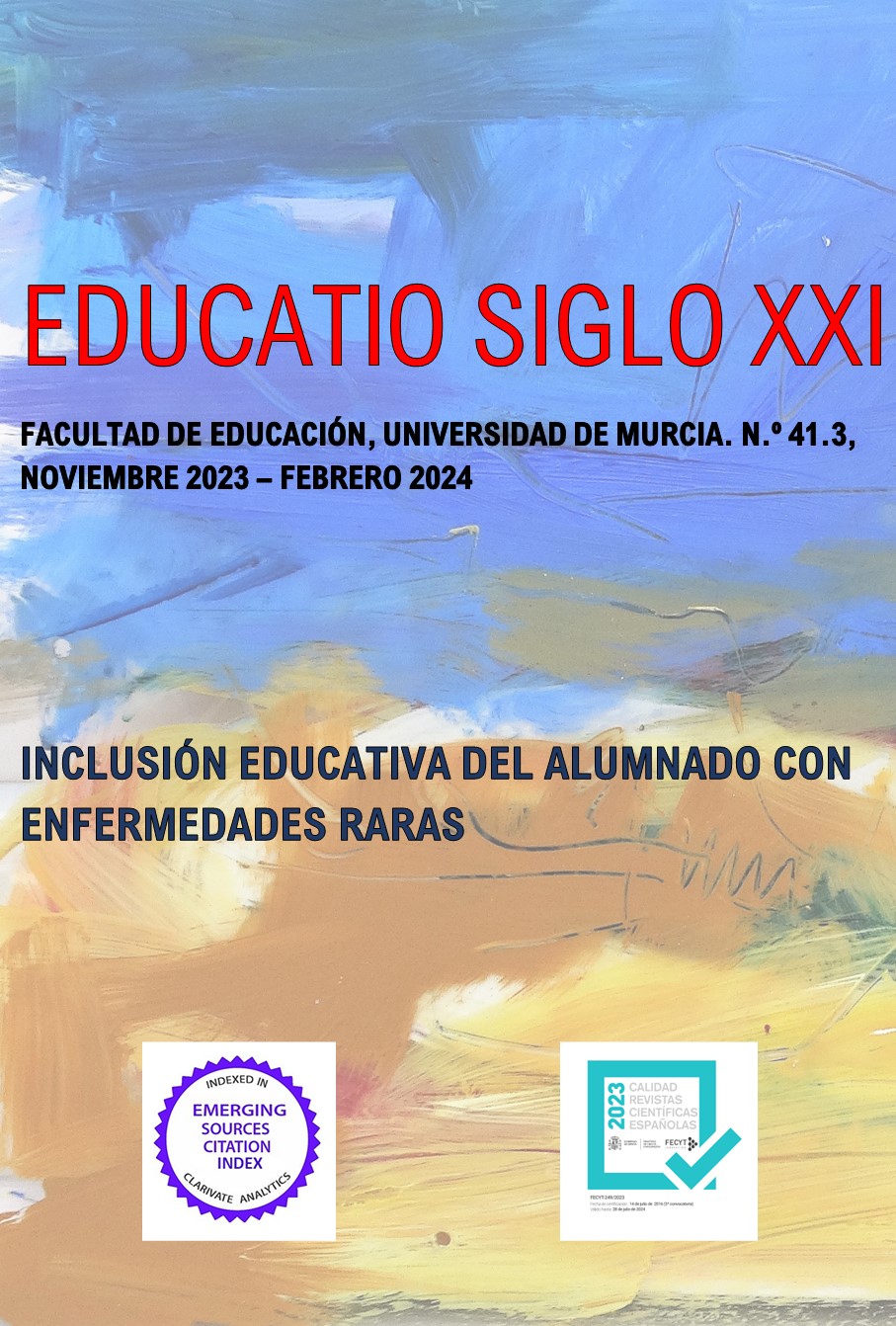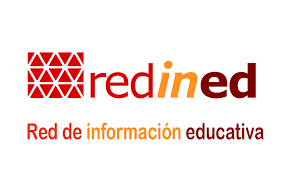Resources for the educational inclusion of students with rare diseases
Abstract
This paper presents a study whose objective was to characterize the formative, human, physical and community resources that make up good educational practices for the educational inclusion of students who suffer from a rare disease, as well as to detect the needs felt by professionals and families in about these resources. For this, a cross-sectional and qualitative study was developed in which educational and health professionals, families and students with this type of pathology participated. The results suggest that the resources considered key are educational, human, and community resources, and that their orientation should focus on providing teachers with intervention strategies rather than on informing about these diseases. In addition, the existing human and physical resources are valued positively, although the need to expand them is pointed out, especially through the figure of educational technical assistants. Physical resources and materials are considered sufficient and the role of traditional resources as a complement to ICTs is highlighted. Another central element highlighted by the participants was the coordination and interdisciplinarity in addressing the needs of these students. Finally, the implications of these results for the development of inclusive practices are discussed, the main limitations of the study are presented, as well as future lines of intervention and research are outlined to continue advancing in the educational and social inclusion of these students.
Downloads
-
Abstract793
-
PDF (Español (España))455
References
Alfaro, A. y Negre, F. (2019). Análisis de las necesidades de información que presentan los docentes respecto a la atención educativa del alumnado con enfermedades raras. Revista Electrónica Interuniversitaria de Formación del Profesorado, 22(1). https://doi.org/10.6018/reifop.22.1.326341
Amiama, J.F., Ledesma, N. y Monzón, J. (2017). La participacion del alumnado en proyectos educativos vinculados al territorio: Propuestas inclusivas en un centro escolar de Secundaria. Aula Abierta, 46, 91-96. https://doi.org/10.17811/rifie.46.2.2017.91-96
Azorín-Abellán, C.M. (2018). The Journey towards Inclusion: Exploring the Response of Teachers to the Challenge of Diversity in Schools. Revista Colombiana de Educación, 75, 39-57. http://www.scielo.org.co/pdf/rcde/n75/0120-3916-rcde-75-00039.pdf
Azorín, C., & Ainscow, M. (2020). Guiding schools on their journey towards inclusion. International Journal of Inclusive Education, 24(1), 58-76. https://doi.org/10.1080/13603116.2018.1450900
Bayo, R. y Moliner, O. (2021). Alumnado con enfermedades poco frecuentes (EPF) en las aulas ordinarias: ¿cómo se garantiza su presencia, participación y aprendizaje?. Revista de Investigación Educativa, 39(2), 571–586. https://doi.org/10.6018/rie.449011
Blanco, R. (2008). Marco conceptual sobre educación inclusiva. La educación inclusiva. El camino hacia el futuro. Aportes a las discusiones de los talleres de la Conferencia Mundial de Educación. OIE/UNESCO. https://unesdoc.unesco.org/ark:/48223/pf0000162787_spa
Booth, T. y Ainscow, M. (2015). Guía para la educación inclusiva. Desarrollando el aprendizaje y la participación en los centros escolares. OEI/FUHEM.
Cabrerizo, J. y Rubio, M.J. (2007). Atención a la diversidad: Teoría y pràctica. Prentice Hall.
Cardinali, P., Migliorini, L., & Rania, N. (2019). The caregiving experiences of fathers and mothers of children with rare diseases in Italy: Challenges and social support perceptions. Frontiers in Psychology, 10, 1780. https://doi.org/10.3389/fpsyg.2019.01780
Darretxe, L., Berasategi, N. y Gaintza, Z. (Coords.). (2022). Buenas prácticas inclusivas en respuesta al alumnado con enfermedades raras: Estudio en diferentes comunidades autónomas. Octaedro.
Darretxe, L., Gaintza, Z., & Monzón, J. (2017). A systematic review of research into rare diseases in the educational sphere. Educational Research and Reviews, 12(10), 589-594. https://doi.org/10.5897/ERR2017.3186
Del Barrio, J.A. y Castro, A. (2008). Infrastructura y recursos de apoyo social, educativo y sanitario en las enfermedades raras. Anales del sistema sanitario de Navarra, 31(2), 153-163. https://scielo.isciii.es/pdf/asisna/v31s2/original11.pdf
Escarbajal, A., Cárceles, J.C. y Izquierdo, T. (2023). La perspectiva del profesorado sobre el contexto escolar en educación inclusiva. Aula Abierta, 52(1), 15–22. https://doi.org/10.17811/rifie.52.1.2023.15-22
Galende, I. (2014). La inclusión educativa y las enfermedades poco frecuentes. Hacia un modelo de coordinación socio educativa y sanitaria en torno a las Enfermedades Minoritarias. Revista de Educación Inclusiva, 7(3) 84‐96. https://dialnet.unirioja.es/servlet/articulo?codigo=4992012
Gimeno Sacristán, J. (1999). La construccion del discurso acerca de la diversidad y sus practicas I. Aula de innovación educativa, 81, 67-72.
Guajardo-Ramos, E. (2018). La educación inclusiva, fase superior de la integración-inclusión educativa en Educación Especial. Teoría y Crítica de la Psicología, 11, 131-153. http://teocripsi.com/ojs/index.php/TCP/article/view/272/221
Intxausti, N., Etxeberria, F., & Bartau, I. (2017). Effective and inclusive schools? Attention to diversity in highly effective schools in the Autonomous Region of the Basque Country. International Journal of Inclusive Education, 21(1), 14-30. https://doi.org/10.1080/13603116.2016.1184324
Kurniawati, A. A. de B., Minnaert, A. E. M. G., & Mangunsong, F. (2017). Evaluating the effect of a teacher training programme on the primary teachers: attitudes, knowledge and teaching strategies regarding special educational needs. Educational Psychology, 37(3), 287-297. https://doi.org/10.1080/01443410.2
1176125
Ley Orgánica /1990, de 3 de octubre, de ordenación general del sistema educativo. Boletín Oficial del Estado, 238, de 4 de octubre de 1990. https://www.boe.es/eli/es/lo/1990/10/03/1
Ley Orgánica 3/2020, de 29 de diciembre, por la que se modifica la Ley Orgánica 2/2006, de 3 de mayo, de Educación. Boletín Oficial del Estado, 340, de 30 de diciembre de 2020. https://www.boe.es/boe/dias/2020/12/30/pdfs/BOE-A-2020-17264.pdf
Menéndez, C., Pevida, M. D. y Dopico, E. (2020). Educación Inclusiva: ¿por dónde empezamos? En E. Díez Gutiérrez y J.R. Rodríguez Fernández (Dir.), Educación para el Bien Común. Hacia una práctica crítica, inclusiva y comprometida socialmente. (pp. 326-334). Octaedro.
Ministerio de Sanidad. (2021). Informe ReeR 2021. Situación de las enfermedades rares en 2010-2018. Centro de publicaciones del Ministerio de Sanidad. https://www.sanidad.gob.es/organizacion/sns/planCalidadSNS/pdf/excelencia/Informe_reer_reducido_2021.pdf
Monzón, J. y Gaintza, Z. (2014). La inclusión escolar y social de alumnado con enfermedades minoritarias. Una oportunidad de innovación y un beneficio para toda la comunidad. Revista de Educación Inclusiva, 7(3), 1-13. https://revistaeducacioninclusiva.es/index.php/REI/article/view/128/122
Parrilla, A. (2001). Escuela inclusiva: aprender de la diferencia. Cuadernos de Pedagogía, 307, 44-49.
Paz-Lourido, B., Negre, F., de la Iglesia, B., & Verger, S. (2020). Influence of schooling on the health-related quality of life of children with rare diseases. Health and Quality of Life Outcomes, 18, 109. https://doi.org/10.1186/s12955-020-01351-x
Slade, A., Isa, F., Kyte, D., Pankhurst, T., Kerecuk, L., Ferguson, J., Lipkin, G., & Calvert, M. (2018). Patient reported outcome measures in rare diseases: a narrative review. Orphanet Journal of Rare Diseases, 13:61. https://doi.org/10.1186/s13023-018-0810-x
Slee, R. (2012). La escuela extraordinaria. Exclusión, escolarización y educación inclusiva. Morata.
Organización de las Naciones Unidas para la Cultura, las Ciencias y la Educación. (2017). A guide for ensuring inclusion and equity in education. United Nations educational, Scientific and Cultural Organization. http://unesdoc.unesco.org/images/0024/002482/248254e.pdf
Organización de las Naciones Unidas para la Cultura, las Ciencias y la Educación. (2020). Towards inclusion in education: Status, trends and challenges. The Unesco Salamanca Statement 25 years on. United Nations educational, Scientific and Cultural Organization. https://unesdoc.unesco.org/ark:/48223/pf0000374246
Valenzuela, B.A., Guillén, M. y Campa, R. (2014). Recursos para la inclusión educativa en el contexto de educación primaria. Infancias Imágenes, 13(2), 64–75. https://doi.org/10.14483/udistrital.jour.infimg.2014.2.a06
Verger, S., Roselló, M.R. y De la Iglesia, B. (2016). Educación física y atención al alumnado con enfermedad crònica en la escuela. Revista de Psicología del Deporte, 25(1), 195-200. https://www.redalyc.org/pdf/2351/235143645024.pdf
Wakap, S. N., Lambert, D. M., Olry, A., Rodwell, C., Gueydan, C., Lanneau, V., Mury, D., Le Cam, Y., & Rath, A. (2020). Estimating cumulative point prevalence of rare diseases: analysis of the Orphanet database. European Journal of Human Genetics, 28(2), 165-173. https://doi.org/10.1038/s41431-019-0508-0+
Waldman, H.B., Perlman, S.P., Munter, B.L., & Chaudhry, R.A. (2008). Not so rare, rare diseases. Exceptional Parent, 38(12), 46-47.
Warnock, H.M. (1978). Special Educational Needs. Report of the committee of enquiry into the education of handicapped children and young people. Her Majesty’s Office.
Copyright (c) 2023 Servicio de Publicaciones de la Universidad de Murcia

This work is licensed under a Creative Commons Attribution-NonCommercial-NoDerivatives 4.0 International License.
Original work publishes in this journal is subject to the following terms:
1. Murcia University Press (the publishing house) holds the copyright of the publishes work, and favours and allows their reutilization under the use license stated in point 2.
© Servicio de Publicaciones, Universidad de Murcia, 2015
2. Work is published in the electronic edition under a license (Creative Commons Reconocimiento-NoComercial-SinObraDerivada 4.0 España (legal text). They can be copied, used, disseminated, transmitted and publicly presented, as long as: i) authorship and original publication source is acknowledged (journal, publishing house and URL of the work); ii) are not used for commercial purposes; iii) the existence and specifications of this use license is stated.
3. Conditions for self-archive. Authors are allowed and encouraged to disseminate electronically the pre-pint (before review) and/or post-print (accepted for publication) versions of their work before their publication since that favours earlier circulation and dissemination resulting in an increased chance for the authors to be cited and for the work to reach a bigger share of the academic community. Colour: RoMEO: green.







